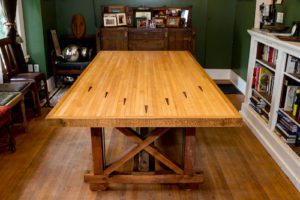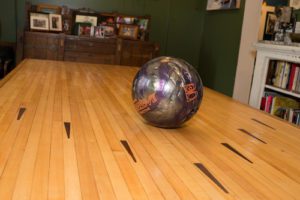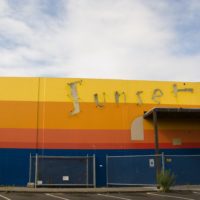1.
I never bowled at the Sunset Bowl in Ballard, but I would drink there sometimes, especially after the paper announced it would succumb to the same bulldozer that whacked the Denny’s across the street. Back then, I drank Bud Light. Everybody drank Bud Light. At Sunset Bowl, Bud Light came in glass bottles that were shaped like bowling pins so we could knock ‘em down without ever setting foot in a borrowed shoe.
2.
My house was close. I could walk to the bowling alley to drink. I walked because it was responsible to walk, but also because walking was a way to participate in the changes to the neighborhood, to observe them, at least, when I didn’t anticipate or cause them. New tulips in a parking strip said someone owned the place. Exposed plywood on a neighbor’s new wing said it was cheaper to expand a crappy house than to buy a bigger one. Closed curtains with piled belongings stuffed against the pane did not say ownership necessarily, but they did say someone had taken their nesting instinct literally. When the wrecking ball finally came, certain neighbors would welcome it.
3.
The rent I paid on the house where I lived within walking distance of Sunset Bowl funded my landlord’s mortgage. He lived in the basement while he saved money—my money—for the day he could afford the main floors of his own house. When I moved to Ballard I did not want to buy a house; but once I saw that I could not, no way, ever afford one—that my landlord couldn’t even afford one—I felt a kind of loss I still don’t know how to name. My life here would be temporary. I could see that now.
4.
So what, while I lived here, could I be? Signs of working-class prosperity were everywhere, from the Sears-kit Craftsman bungalows to the fast food strip and fishermen’s bars, but in 2007, the neighborhood’s outer landmarks were about to come down. I had enough time to visit, pay homage, but not enough for the buildings to sink deeper into me than an image. Despite my few evenings in the bar, I remember the Sunset Bowl most as a flash of blue in my right eye as my boyfriend drove me downtown. I was too young. I had arrived too late.
5.
A year before the economy collapsed, I moved from Capitol Hill to Ballard because the man I loved lived on the ridge above the neighborhood. I wanted to be near him but not too near him. I wanted to be part of his friend-family but stay on speaking terms with places where I wasn’t so clearly girlfriend to the singer in the country band. My boyfriend could count on two hands the number of times the press wrote “whiskey-soaked” to describe his music, and could always get half our drinks free as long as our bar crawl stayed north of the shipping canal and west of the interstate. I learned, from him, to tip the balance of what you were comp’d and to do it in cash because a debit card won’t process a gratuity that’s bigger than the balance. We wore cowboy boots like we’d just discovered them and thought naming a dog after Willie Nelson was a fine new thing.
6.
In our first month on the new block, my roommate Lindsey pissed off Kathy next door by parking her truck outside Kathy’s house. “Go back to Capitol Hill!” she yelled when Lindsey insisted that the spot belonged to the city, not to Kathy. “Go back to Bellevue!” Lindsey yelled back. Sometimes, over the four years we lived in that house, we’d catch Kathy spying on us from her basement window. If we’d been drinking, we might make faces and wave at her. Other times she marched right out her front door and wished us a good morning as if we were her favorite neighbors, and on those days we did the same.
7.
Our across-the-street neighbor Bobbie worked at the Sunset Bowl’s bar. If we met on the sidewalk she’d tell me my cat was cute, but in the bowling alley bar we did not know each other, she would not look at me. When I first saw her clearing dead soldiers from the lounge, I thought, “Lucky! She can walk to work.”
8.
One day an acquaintance who’d just asked me to drive her home to the Central District told me Ballard was “a nice place to live if you want to play it safe.” I took safe as code for straight and white and didn’t know what to say, because Ballard—what I knew of it—was very white and was very straight, but hell, so was most of my family.
9.
When I think about it now, I think about the binary within that code. What is not-straight and not-white is not safe; safe can mean one is free of physical harm or it can mean one is ossified by boredom. I wonder what she was trying to tell me about herself—that when she chose her neighborhood she used a moral compass, while I merely chose what sounded like a real good time?
10.
 Sitting here, in 2016, I wonder what landmarks my acquaintance uses today to cite proof of her early presence in the now nearly gentrified CD. I wonder if they describe her accurately—whether or not she intends them to—as one ripple within a wave of people who felt refreshed and refreshing because at the time they believed that feelings were facts. What feels new is new, what feels like mine is mine. My neighborhood, people say, because they had the wisdom to move there. In mid-2007, in our mid-twenties, with our non-profit jobs and self-righteous pride, my acquaintance and I could afford to entertain ignorance, ambivalence, or just not care at all that to reinvent the self in the image of a neighborhood exerts a force that also reinvents the neighborhood. This claiming of “new” territory made an aesthetic contribution that created economic value we and many of our neighbors couldn’t afford, and within five years it would be bought out from under us.
Sitting here, in 2016, I wonder what landmarks my acquaintance uses today to cite proof of her early presence in the now nearly gentrified CD. I wonder if they describe her accurately—whether or not she intends them to—as one ripple within a wave of people who felt refreshed and refreshing because at the time they believed that feelings were facts. What feels new is new, what feels like mine is mine. My neighborhood, people say, because they had the wisdom to move there. In mid-2007, in our mid-twenties, with our non-profit jobs and self-righteous pride, my acquaintance and I could afford to entertain ignorance, ambivalence, or just not care at all that to reinvent the self in the image of a neighborhood exerts a force that also reinvents the neighborhood. This claiming of “new” territory made an aesthetic contribution that created economic value we and many of our neighbors couldn’t afford, and within five years it would be bought out from under us.
11.
The summer of 2009, demolition fences circled the Sunset Bowl and Lynn Shelton made a movie that co-starred my boyfriend’s band. She cast me in a supporting role, a true version of myself: the girlfriend who smiles at his side while he’s interviewed, the girlfriend who smiles through irritation when one morning after a show at the Tractor, a strange woman answers his front door. It was impossible not to smile during filming—I was too impressed to stop myself. As I sat inside my smile and tried not to look at the camera, I thought, “When I die, this will be what’s left of me.” My wardrobe was picked from my actual clothing, so now I knew which of my dresses looked the most like what my boyfriend’s girlfriend would drape around her body. During a crowd scene, Lindsey was asked to change into something more plaid, and—though she looked as she usually looked when attending her boyfriend’s shows—she did what they asked and changed quickly. She wanted to be in the movie. We all did. This document would prove beyond a shadow of a doubt that in the summer before the Sunset Bowl finally came down, we existed.
12.
None of the movie’s reductions to band-girlfriend were actually ugly or fake, but the choices required of image-making made me queasy. In Lynn’s mirror, I saw our little patch of territory in the city’s music scene as something utterly describable, a set of clothing and grooming and beer choices that were not ours, not ours at all. I saw myself watching these men onstage, how I was in thrall to them way they were in thrall to the outlaw cowboys they idolized. I’m simplifying here. When I say ours, understand I mean that in the community I’d chosen I could not buy a house, could not own a part of my place. My private place was precarious, while what was publicly mine—my boyfriend, my spot next to him, my underpaid arts admin job—cast me in a supporting role. If it suited me to think my experience was truly that narrow and that it echoed entire neighborhoods’, it was because frustration felt like the thing I could kick against to get myself free.
13.
The recession continued. I lost my retirement account, a cost-of-living raise, and my good health insurance. Around my home and workplace and all over town, pits in the ground stayed pits in the ground. Those cavities were my consolation. For the moment, we were all in the hole.
14.
During that time, I tracked down photos of the Denny Regrade, whose reformation of a steep slope that horses and plumbing could barely climb made the Denny Triangle look like Monument Valley. Impossible stories of dirt, gouged and tall and teetering, with a few timber baron mansions still clinging to their panoramic Elliott Bay views. Those houses sat on the precipice of destruction for the sake of shit and traffic and the gentler flow of both. The Denny Regrade is the only eminent domain project in history where the city demolished its richest neighborhood for the sake of public health.
15.
I made that last fact up. But doesn’t it sound true, or at least plausible? Doesn’t it feel comforting to think so?
16.
I left Ballard in 2013, and I still don’t know if redevelopment is refreshing or destructive. To say “both” feels too easy. I do know this: To say “I was here first” is always a claim of authenticity, and authenticity is constructed just like buildings and movies and relationships are constructed. It’s made up of dreams and raw materials and pieces of what came before that we borrow, buy, and steal. We construct authenticity to say—regardless of who was here first—I am here now, and I deserve to stay.
17.
There was a period after Sunset Bowl was demolished when you could find parts of it all over town. Bowling lanes were recycled into flooring for new condos. In new restaurants you could find refurbished bar chairs and low square tables, gleaming where their adoptive owners had razored off coats of cigarette smoke. Even those Bud Light bowling pins reappeared. The Sunset Tavern bought them at auction, I think. Or maybe a friend did. I drank one more before they disappeared from my life forever.
18.
During the months I could recognize pieces of the Sunset Bowl, it seemed like a body we’d dismembered and eaten and gotten fat on. This was cool, this recycling—better than throwing everything away—but it was also sinister, like the circle of Dante’s hell where people feast without satisfaction. Could you say you touched a piece of Ballard history if you walked lanes seven and eight from the craft cocktail bar to the ladies room? Could you say you were intimate with the neighborhood, that this place was inside you, in your bones, if you drank beer from the bowling pin bottles? I walked. I drank. I didn’t have to own something to live it.
19.
 There’s a part of Richard Hugo’s Triggering Town, his 1979 book on poem writing, where he says that as we lose certainty, our imaginations preserve the known world by internalizing it, keeping it as it was—the bowling alley still a rainbow-blue box in the neighborhood of my mind, the Denny’s still a wave of dank yellow across memory’s street—so that those fixed knowns can make room for the “unknowns of the poem,” the parts the poet discovers, and the reader with her. As I understood it, to Hugo it was better if I never ate at that Denny’s or bowled at Sunset Bowl—if I wanted to write a poem about them, anyway. Which I think also means that if I want to authentically approach the mystery of my neighborhood—its unknowable interiors, the pieces and people we were displacing and becoming—I have to be able to imagine them. The route to understanding runs through the self. So it starts with my limits. It starts with what I don’t—can’t—didn’t want to—know.
There’s a part of Richard Hugo’s Triggering Town, his 1979 book on poem writing, where he says that as we lose certainty, our imaginations preserve the known world by internalizing it, keeping it as it was—the bowling alley still a rainbow-blue box in the neighborhood of my mind, the Denny’s still a wave of dank yellow across memory’s street—so that those fixed knowns can make room for the “unknowns of the poem,” the parts the poet discovers, and the reader with her. As I understood it, to Hugo it was better if I never ate at that Denny’s or bowled at Sunset Bowl—if I wanted to write a poem about them, anyway. Which I think also means that if I want to authentically approach the mystery of my neighborhood—its unknowable interiors, the pieces and people we were displacing and becoming—I have to be able to imagine them. The route to understanding runs through the self. So it starts with my limits. It starts with what I don’t—can’t—didn’t want to—know.
20.
Hugo was born in White Center in 1922 and worked as a technical writer for Boeing during the early 1960s, when Eisenhower’s Interstate plowed up the middle of Seattle. “I believe the accelerated loss of knowns accounts for the increasing number of people writing poems,” he wrote. His next line is “The self is inadequate and will not do,” which sounds like a possible explanation—in some mouths, an excuse—for why Seattle has to change or become like that hoarder’s house on the corner, where every item deserves to be kept, a democratizing of objects that turns them all into garbage.
21.
What if inadequacy is a place to start from, the crack that lets the light in, a stubborn lack we might as well use for creative purposes since it’s here to stay? This would remake insecurity—of the self, of finances and property, of how to belong—into a force that compels us to break the stagnant images we inherit and replace them with images that look steady and right and new, until one day, years pass, and with one hard look, they too dissolve before us.
22.
The summer before the Sunset Bowl finally came down, there was some conflict on my block. Bobbie’s daughter-in-law concluded an argument by spraying her husband with a power-hose. The last of the screaming took place on the front lawn. The cops came. We heard about a bruise, broken bones, a restraining order. We peered through our rented windows and gossiped, of course we did, about the extended family who lived in both sides of the single-story duplex on the corner. I didn’t know Bobbie well enough to ask if she was okay, and I didn’t want to. Keeping to my side of the street seemed neighborly at the time. It still seems neighborly.
23.
The Sunset Bowl closed for good at one a.m. on April 14, 2008. It was shorn of its lanes and shoes and ball polishers, relieved of its bowling pin Bud Lites and cheap whiskey tumblers, emptied of its spoons and saucers and thick-lipped coffee mugs and little silver half-n-half pitchers, all of which were auctioned off to mourners and strangers alike. I went to work. The building sat behind chain link, waiting for money to flow back through Ballard. I paid my bills. Our landlord dreamed of what he would do with the house when he moved upstairs—gut the top floor, tear out the wall between kitchen and dining room, mount an aquarium in the stairwell—but he didn’t raise our rent. Lindsey married her boyfriend and moved out. My boyfriend moved in. Finally, on January 20, 2010, a crane took the first bite out of the derelict building, starting with the lounge. The Sunset Bowl became a mute pit on the edge of our attention, silent for almost a year. Shortly before AvalonBay Communities broke ground on their new condo that September, I would leave my boyfriend and that Ballard house. But in the meantime, there was a winter and spring and summer where Bobbie and I continued smiling at each other from our front porches, the street a gulf of asphalt between us. After every good storm we’d hear the sewer rushing beneath the grate. All that shit and soap and rainwater running back to a bay whose salt we could smell when the wind blew, evidence of waves we could not see but trusted were still there, westward, out where the day and the neighborhood ended.
***
This essay is excerpted from the forthcoming anthology Ghosts of Seattle Past (Chin Music Press, ed. Jaimee Garbacik).
***
Feature image by Brad Stemke. Images of table made from Sunset Bowl lane by James Taylor (Photo credit: Victoria Holt).




